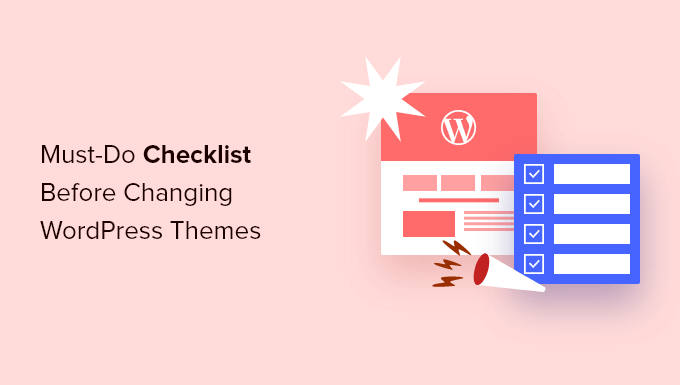8 Things You Must Do Before Changing WordPress Themes
The first thing you must do before changing your WordPress theme is to check all its functions. If you have installed plugins, make sure they work and add them to your new theme. Test all the features of your new theme, including commenting, single posts, search, 404 page, archives, contact page, widgets, and more. If you notice that some of your features are not working, you must change your theme.
Check for inconsistencies
Before making any changes to your WordPress theme, be sure to check for inconsistencies. Custom themes are often more vulnerable to breaking when WordPress updates core functionalities. Ideally, themes should use native functionality. Additionally, the developers of a WordPress theme ensuring that their own features work properly. But, the more customizations you make, the more likely you will encounter problems in the future. So, before making any changes to your theme, make sure that the changes you make are documented in the folders where you are storing the theme files.
Another important thing to check for inconsistencies is the performance of your site. Different themes can affect different elements of your website. For example, a blog theme can impact individual posts, categories, and listings. An e-commerce theme will have different impacts on product pages and listings. In addition, consider the load time of the new theme. If the previous one took longer to load, the new theme might take even longer to do so.
Before making any changes to your WordPress theme, you should back up your site. Even if you have made the switch, you don’t need to lose your entire site. Before making any changes, make sure to back up your database, themes, and any other files necessary for the new theme. If something goes wrong, you’ll be able to revert to the old theme if necessary.
Another item to check before reversing WordPress compositions is the page load time. Since WordPress themes are not optimized for speed, they can increase the page load time of your site. If you are unsure of how much the new theme affects your site’s load time, using speed testing tools. While you’re at it, take note of the sidebar content. Changing your theme without preserving the content can cause your site to load slowly and negatively affect your site’s search ranking.
Check for malicious code
Before making any changes to your WordPress theme, it is a good idea to run a malware scan. This can be done using a few different programs. The best way to run a malware scan is to use a reputable theme security scanner. There are many different tools to do this, including Wordfence, BulletProof Security, Sucuri, and iTheme Security. These scanners will detect hidden links, malicious scripts, and other code on your theme that can make your website vulnerable.
If you notice any suspicious code, immediately delete the file or use a malware scanner. Malicious code is almost always hidden in the coding of a WordPress theme, and if you do not notice it, you may have accidentally installed it. You will be notified that malicious code has been injected into the theme when a user attempts to submit a form that requires them to enter their email address. In order to protect your website from this risk, you need to implement proper data validation on all forms on your site.
Malicious code can affect your site’s performance and revenue, so it is very important to check for malware before you make any changes to your WordPress theme. Infected themes can send your visitors to phishing sites, which often contain adult content or useless products. In addition to these, they can also cause your website to become infected with malware. The best way to avoid this is to use a legitimate theme that doesn’t have malicious code.
To confirm your WordPress website’s safety, you should consistently change the URL of your site from HTTP to HTTPS. To do this, go to Settings -> General and look for the Site Address (URL) field. Another thing to keep an eye on is outdated themes and plugins. Delete and deactivate any outdated plugins and themes and use secure login credentials to log in to your site. Uninstall redundant plugins
Before changing your WordPress themes, uninstall any plugins that are no longer required. A lot of plugins can cause your site to load slowly and can even pose a security risk. It is therefore vital to uninstall any unused plugins. A good place to start is by looking through all the plugins that you currently have installed on your site. Only keep the ones that you need. This way, you’ll ensure that your site is as secure and fast as possible.
Before you change your WordPress theme, make sure you’ve uninstalled any redundant plugins. These are typically used for specific functions, like search engine optimization. If you’re changing your theme, you’ll want to make sure that the new design complements your current plugins. This means making sure that your new theme works with any browser, regardless of the version. Check that the theme you choose is compatible with XHTML and CSS standards.
If you’re worried about accidentally uninstalling a plugin, you can use phpMyAdmin. This tool can help you find the plugin you’ve deleted. It will permit you to search for it by name, and term, Once you’ve found the plugin you’d like to remove, simply click on the Delete option in phpMyAdmin. Alternatively, you can use another plugin to remove the files that were left behind by the previous one.
Themes can be tricky to install. If you’re installing a new theme on your existing site, you may have to reinstall some plugins to make them work. If you’ve downloaded a theme from a third-party website, there are chances that your site still contains the default version of the theme. PHP frameworks
Check for compatibility with all major browsers
Before changing your WordPress theme, check if it is compatible with all the major browsers. The different browsers display the same elements differently and your new theme may not look good across them. You can use automated test tools to find out if the theme you’re considering is compatible with all the major browsers. Other factors to consider before changing your theme include plugin compatibility and SEO friendliness.
Before making any changes to your theme, make sure the site is in maintenance mode. The maintenance mode will last about fifteen to twenty minutes. This will give you a chance to make sure the theme works properly before activating it. While the site is in maintenance mode, you can test the new theme on multiple devices. If you have a mobile device, use a phone or tablet to test the theme.
If you’re planning to change your WordPress theme, be sure to ensure that it is compatible with all the major browsers. Using a tool such as BrowserStack can help you perform cross-browser testing of your new theme. BrowserStack offers plugin integration for WordPress. You can also use BrowserStack Automate to automate human interaction with websites. This tool works in any language or framework.
Cross-browser compatibility is essential for the longevity of a website. Many users use Chrome to view websites, but you should also make sure that your new theme is compatible with the major browsers. According to Statcounter, Google Chrome is the most popular browser for web browsing, and WordPress theme designers often test new layouts on this browser before publishing them to the public. If it’s not, your website’s visitors and conversions will suffer.
Check for compatibility with all major devices
Before making any changes to your website, you should always test your theme’s compatibility with all major browsers. This is especially important since IE tends to render things differently. If you want your site to be optimized for search engines, make sure your theme is compatible with major devices, such as smartphones and tablets. Simply enter your website URL into the tool and run a test to see if it is compatible.
WordPress themes can be confusing to choose from. You need to choose a theme that is compatible with all of the major browsers, including IE8 and Chrome. But compatibility with major devices has become increasingly important as screen sizes vary greatly. Even Google checks the responsiveness of websites on mobile devices and tablets. While responsiveness is a de facto standard, some themes still won’t render well on all viewports.
Changing your theme can have a drastic effect on your website’s accessibility. Studies show that nearly 55% of website views are made from a mobile device, including various types of smartphones. It is crucial that your website’s theme is responsive and compatible with these devices. Your current users will likely check out your site on their mobile devices immediately after you switch it. Make sure your new theme is mobile-friendly and compatible with all major devices before making a big change. Your existing users will remain loyal to your site and keep visiting. top 5 php framework.
Changing your WordPress theme isn’t a simple process. You need to be mindful of a number of factors and ensure your site is accessible to all devices. If you do it improperly, your website will become incompatible or unresponsive. In addition to preventing problems, changing your theme can also improve your website’s search engine ranking and make it more user-friendly. So take your time and do it the right way.





Pingback: LCDs with 480 Hz Refresh Rate Incoming - FDTechy